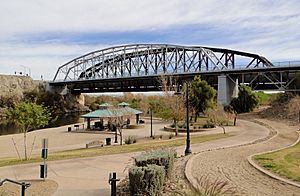Ocean to Ocean Bridge facts for kids
Quick facts for kids Ocean-to-Ocean Bridge |
|
|---|---|
 |
|
| Coordinates | 32°43′43″N 114°36′56″W / 32.7287°N 114.6156°W |
| Carries | Penitentiary Avenue, pedestrians and bicycles |
| Crosses | Colorado River |
| Locale | Yuma, Arizona, United States |
| Named for | Ocean-to-Ocean Highway |
| Owner | Yuma County, Arizona |
| Inventory No. | 08533 |
| Characteristics | |
| Design | Through truss bridge |
| Material | Steel |
| Pier construction | Concrete |
| Total length | 444 ft (135 m) |
| Width | 35 ft (11 m) |
| Longest span | 336 ft (102 m) |
| Number of spans | 2 |
| Piers in water | 1 |
| History | |
| Designer | Bureau of Indian Affairs |
| Constructed by | Omaha Structural Steel Works |
| Construction begin | September 1914 |
| Construction end | 1915 |
| Construction cost | $73,800 |
| Opened | 22 May 1915 |
| Rebuilt | 1943; 2002 |
|
Ocean to Ocean Bridge
|
|
| Nearest city | Yuma, Arizona |
| Area | 0.2 acres (0.081 ha) |
| Built | 1914 |
| Built by | Omaha Structural Steel Works, Office of Indian Affairs |
| MPS | Vehicular Bridges in Arizona MPS |
| NRHP reference No. | 79000431 |
| Added to NRHP | September 11, 1979 |
The Ocean-to-Ocean Bridge is a special bridge that crosses the Colorado River in Yuma, Arizona. It was built in 1915 and was the very first highway bridge over the lower Colorado River. It's also the only bridge of its kind (a Pennsylvania truss) in Arizona.
This bridge was once a key part of a big road called the Ocean-to-Ocean Highway. Later, it became part of US 80. In 1956, a new bridge was built, and the Ocean-to-Ocean Bridge was used only by people walking or biking for many years. After a big repair project, it reopened to cars in 2002. Today, it's part of Historic US 80.
Contents
Building the Bridge: A Look Back
In 1913, people in Yuma really wanted a permanent bridge over the lower Colorado River. Their representative, Carl Hayden, asked the government for help. Congress agreed to fund the bridge. The money came from the Office of Indian Affairs (OIA). This was because the bridge would connect Yuma to the nearby Fort Yuma Indian Reservation.
Who Designed and Paid for It?
The State of Arizona and Imperial County, California also helped pay, each giving $25,000. Engineers from the OIA in Washington D.C. designed the bridge. They planned for it to be made of steel, with a special "Pennsylvania through truss" design. It would also have a "Warren deck truss" section. Both parts would rest on strong concrete supports in the river. The bridge was to be built a little upstream from where a ferry used to cross the river.
Construction Challenges and Success
The company chosen to build the bridge was Omaha Structural Steel Works. They won the contract in June 1914 for $73,800. Construction started in September 1914. Building the bridge was tricky because the Colorado River's currents and floods were hard to predict. The temporary structures built to help with construction were washed away twice by floods!
Omaha Steel decided to try a different way. They built the bridge sections on barges. Then, they floated each section down the river and carefully moved it into place. On March 3, 1915, the main 336 ft (102 m) section was put into position. People in the area celebrated this big achievement. The Ocean-to-Ocean Bridge officially opened to the public on May 22, 1915. It quickly became a very important link for the Ocean-to-Ocean Highway. It was also the first highway bridge over the lower Colorado River.
The Bridge's Journey Through Time
On November 11, 1926, the Ocean-to-Ocean Bridge became part of U.S. Route 80. This highway was the main east-west road in Arizona. In the 1920s and 1930s, most of the state's car traffic used US 80.
A Time of Change and New Roads
During the Great Depression in the 1930s, the bridge saw many people traveling. Some people, often called "Okies," were trying to find work in California. They were sometimes stopped by police at the bridge. Many of these families ended up finding important farm work around Yuma County.
In 1956, US 80 was moved to a newer bridge built nearby. After this new bridge and the building of Interstate 8 in the early 1970s, fewer cars used the Ocean-to-Ocean Bridge. The importance of US 80 also decreased over time.
Becoming a Historic Landmark
In 1978, the bridge was added to the National Register of Historic Places. This meant it was recognized as an important historical site. Even with this honor, cars were no longer allowed on the bridge after 1988. It was only for people walking or biking.
In 2001, a big project began to fix up the bridge. This cost $3 million. The bridge was closed even to pedestrians during this time. After the repairs were finished, the bridge reopened to traffic in 2002. It now carries Penitentiary Avenue. On September 21, 2018, the Arizona Department of Transportation officially made the Ocean-to-Ocean Bridge part of Historic U.S. Route 80.



